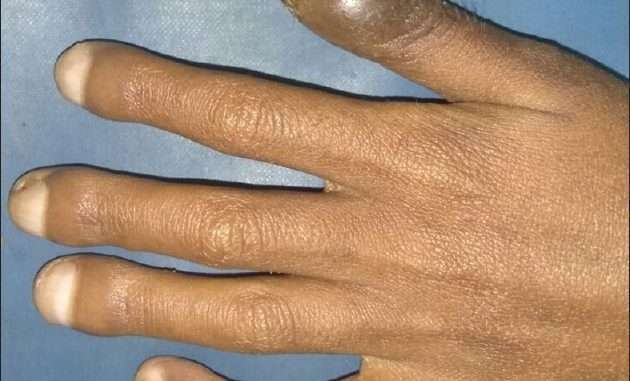
Finger clubbing is an enlargement of the fingertips and downward sloping of nails. It can be a sign of medical problems like lung cancer and heart disease. Therefore, nail clubbing occurs from a buildup of tissue in the ends of the fingers. Clubbing may result from chronic low blood oxygen levels. This can be seen with cystic fibrosis, congenital cyanotic heart diseases, and several other diseases. The tips of the fingers enlarge and the nails become extremely curved from front to back. The clubbing itself is not harmful.
Symptoms of Finger Clubbing
Warm, red nail beds.
Softening of the nails.
Nails beds that soften and feel spongy.
Disappearing the angle between the nails and cuticle.
Enlargement of the distal portion of the finger.
Nails that are curved downward and look like the bottom of the round part of a spoon.
- Keanu Reeves Bio, Age, Edu, Success, Net worth.
- Michael Strahan age, origin, children, wife, net worth, tv shows.
- Shiri Spear Bio, Wiki, DC Now News, Age, Education, Family, Children, Husband, Net Worth, and Career
- Tasmin Mahfuz Bio, Wiki, DC News Now, Age, Education, Family, Children, Husband, Net Worth, and Career
- Jack Otter Bio, Wiki, FBN, Age, Education, Height, Family, Wife, Children, and Career
- DJ Shockley wiki, age, children, wife, net worth, career.
- John McEnroe bio-Age, family, wife, children, net worth.
Causes of Finger Clubbing
Lung disease – a condition that reduces lung function can reduce circulating oxygen levels and trigger clubbing. However, lung disease, especially cancer, is the most common cause of clubbing.
Cardiovascular Disease –a condition that interferes with blood circulation can also reduce circulating oxygen levels and trigger clubbing. In addition, it is especially in the extremities.
Trauma- damage to blood vessels or injuries that block them, can reduce circulating oxygen levels.
Chronic liver disease- when the liver is not functioning properly, the blood vessels dilate. However, it can reduce the lungs’ ability to oxygenate the blood.
Diagnosis.
Clubbing is often easy to diagnose using a visual exam alone. However, a healthcare provider may do other measurements to confirm the diagnosis. If the health care provider decides you have clubbing, their first move will be to ask you about your family history. Therefore, the provider will then do a careful history and physical exam. The next move, if any, will depend on what the healthcare provider discovers.
Treatment.
The best treatment for clubbed fingers depends on the underlying cause. In addition, treatment may prevent the clubbing from worsening. In rare cases, can reverse some or all of the physical features of clubbing. However, when chronic, malignant, or persistent conditions cause clubbing the condition is often long-term. In some cases, in particular, congenital causes, corrective surgery may be necessary.
When to see a doctor.
Anyone who thinks they may be experiencing clubbing should contact a medical professional as soon as possible. Getting proper treatment for the underlying cause of clubbing is usually crucial.
Quick facts.
Clubbed fingers occur when the soft tissues of the fingers swell. They become spongy and slowly straighten the curvature of the nail bed.
Clubbing typically occurs as the result of a chronic gastrointestinal condition. The condition interferes with circulating oxygen levels.
Some genetic conditions can also cause clubbing. Cases of clubbing can resolve if treatment addresses the underlying cause.
- List of best private primary schools in Kirinyaga County.
- Kenya Medical Training College, courses, requirements.
- List of Best private secondary schools in Nairobi County.
- Public Universities in Kenya
- Best Public High Schools in Kiambu County.
- The best private primary schools in Nyeri county.
- Kenya Institute of special education, courses.